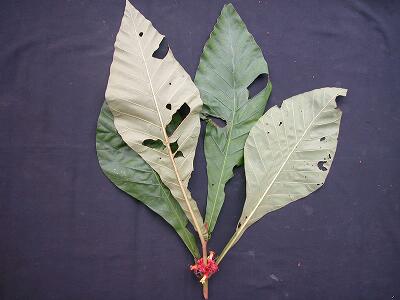Rubiaceae
Pentagonia "australis" C.M. Taylor & Janovec

Kingdom: Plantae Rank: Species Parent: Pentagonia Status: Invalid Reason: unverified
Morphological Description
Latin Diagnosis: Haec species a Pentagonia microcarpa L. Andersson & Rova foliis ad basem angustioribus atque corolla tubulari flava lobis multo brevioribus distinguitur.
Vegetative Morphology
Habit: Shrubs and small trees to 2.5 m tall, apparently unbranched or little-branched .
Branch: Stems rather stout, quadrangular or somewhat flattened to subterete, glabrous.
Leaves: Leaves opposite; blade obovate to broadly obovate, 38--61 x 14--18 cm, drying papery to stiffly papery, adaxially glabrous, abaxially glabrous or sometimes puberulous to densely strigillose on principal veins, tapering for basal 2/3, at base 1.5--2.2 cm wide and abruptly rounded to truncate, at apex acute; secondary veins 16--19 pairs; petioles 0.1--0.5 cm, glabrous.
Stipules: Stipules triangular, 33-40 mm, adaxially sericeous, acute, deciduous.
Reproductive Morphology
Inflorescence: Inflorescences capitate to subcapitate, sessile, with 4--8 flowers; bracts narrowly ligulate to elliptic-oblong, 7--15 mm, obtuse to rounded, glabrous except margins sericeous.
Flowers: Flowers sessile or subsessile; ovary portion slenderly ellipsoid, ca. 4 mm, sericeous; calyx limb yellow to red, externally sericeous, internally glabrous, regularly lobed, tubular portion cylindrical, 5--6 mm, lobes 5, ligulate to narrowly ligulate, 6--8 mm, obtuse to rounded, with margins sericeous; corolla yellow or yellowish green, tubular, externally densely sericeous, internally glabrous, tube ca. 19 mm, at middle ca. 2 mm diam., 2--2.5 mm diam. at mouth, lobes 5, narrowly triangular, 3--3.5 mm, acute; anthers narrowly oblong, 2--3 mm, positioned just above middle of tube and all on one side, overlapping but at different heights; style ca. 9 mm, stigmas narrowly oblong, ca. 2 mm, firmly pressed together.
Fruit: Fruit subglobose, yellow, 0.9--1.2 m diam, sparsely strigillose to glabrescent, finely densely lenticellate.
Seeds: Seeds not seen.
Other
Notes: This species is known from wet forests at an elevation of ca. 270 m in the region of the Rio Los Amigos in southern Peru; it has been collected in flower and fruit in May and June, on some plants simultaneously. The authors find it so incredible that this new species was collected from the banks of the Madre de Dios River, supposedly one of the most collected and well-known floristic regions of the upper Amazon.
Typification
Type Locality: PERU. Madre de Dios: Prov. Manu, Los Amigos Biological Station, Madre de Dios River, ca. 7.0 km upriver from mouth of Río Los Amigos, Trocha Playa 25 m, 24 Jun 2003.
Type Collection: A. P. Maceda 723.
Types Deposited at: USM, BRIT, MO.